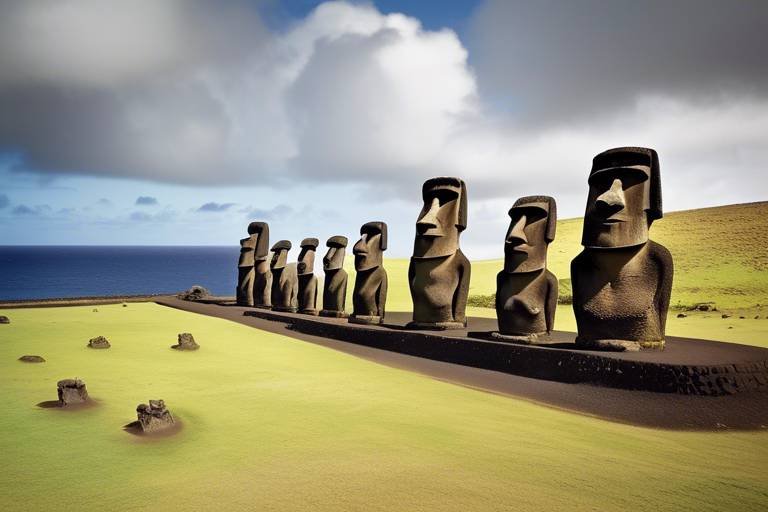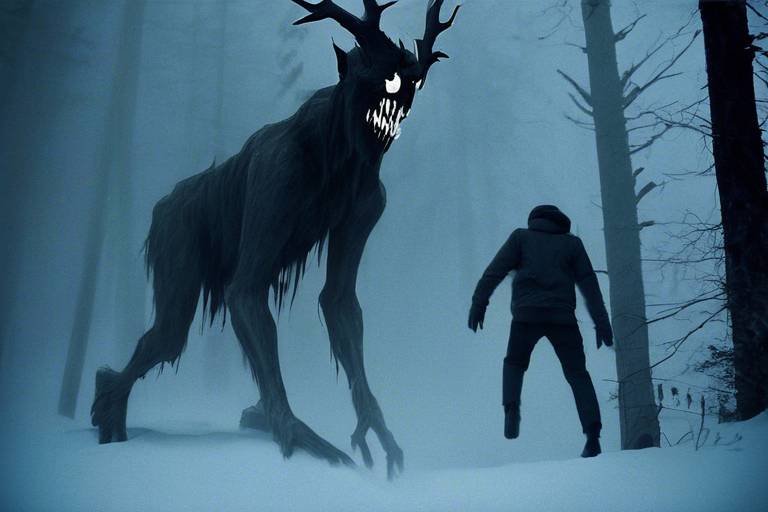The Mystery of the Ancient Celts' Language
The ancient Celts, with their rich tapestry of culture and traditions, left behind a linguistic legacy that continues to intrigue and captivate modern scholars. As we delve into the enigmatic language of the Celts, we are met with a world shrouded in mystery and wonder. The roots of Celtic languages trace back to their Indo-European origins, showcasing a complex evolution and diversification across different regions.
What sets Celtic languages apart are their unique features and characteristics, from intricate grammatical structures to distinct phonetics and vocabulary. Gaulish, Brythonic, and Goidelic branches offer a glimpse into the diverse linguistic landscape of the Celts, each branch carrying its own historical significance and cultural influences.
Surviving written records and inscriptions provide valuable insights into the ancient Celtic languages, offering a window into their beliefs and daily lives. The Ogham script, with its symbolic meanings and cultural significance, adds another layer of complexity to our understanding of Celtic writing systems.
Contemporary efforts to revive and preserve Celtic languages underscore the importance of linguistic diversity and cultural heritage in today's world. Through comparative linguistic studies, we unravel the intricate connections between Celtic languages and neighboring linguistic groups, shedding light on their mutual influences.
As we reflect on the enduring legacy of Celtic languages in modern times, we recognize their profound impact on literature, art, and cultural identity. Preserving and studying these ancient languages is not just a scholarly pursuit but a vital endeavor to safeguard a piece of our shared human history for generations to come.

Origins of Celtic Languages
Tracing the roots of Celtic languages back to Indo-European origins reveals a fascinating journey of linguistic evolution and diversification. The Celtic languages are believed to have originated from the Proto-Celtic language spoken by ancient Celtic tribes in Central Europe. As these tribes migrated and settled in different regions, their language underwent significant changes, giving rise to distinct Celtic dialects.
Through archaeological evidence and comparative linguistic analysis, researchers have identified the Indo-European language family as the ancestral language group from which Celtic languages emerged. The intricate web of linguistic connections between Celtic languages and other Indo-European languages provides valuable insights into the historical development of these ancient tongues.
The Celtic languages further branched out into different groups, including Continental Celtic and Insular Celtic, each with its own set of linguistic characteristics and regional variations. The evolution of Celtic languages reflects the cultural interactions and influences of various civilizations that encountered the Celtic tribes throughout history.

Celtic Language Characteristics
Exploring the enigmatic language of the ancient Celts, a civilization shrouded in mystery and intrigue. Unraveling the linguistic heritage of this ancient people provides insights into their culture, beliefs, and interactions with neighboring societies.Delving into the intricate world of Celtic languages unveils a tapestry of unique characteristics that distinguish them from other language families. One of the defining features of Celtic languages is their rich grammatical structures, which often involve intricate verb conjugations and noun declensions. These linguistic nuances add depth and complexity to communication, reflecting the intricate nature of Celtic culture and thought.
Furthermore, Celtic languages exhibit distinct phonetic patterns that contribute to their melodic and lyrical quality. The phonetic diversity within Celtic languages allows for a wide range of vocal expressions, enhancing the emotive power of speech and storytelling. This phonetic richness is a testament to the expressive nature of Celtic communication, where words are imbued with layers of meaning and emotion.
In addition to grammar and phonetics, Celtic languages boast a vibrant vocabulary that reflects the natural world, cultural practices, and spiritual beliefs of the ancient Celts. Words in Celtic languages often carry deep symbolic significance, connecting speakers to their environment and ancestral heritage. The lexical richness of Celtic languages enables speakers to convey nuanced concepts and evoke vivid imagery through their choice of words.
Moreover, the syntax of Celtic languages exhibits a unique fluidity and flexibility, allowing for creative word order and emphasis in communication. This syntactic versatility empowers speakers to craft elaborate narratives, poetry, and songs that resonate with audiences on a profound level. The rhythmic cadence of Celtic speech, shaped by its syntax, captivates listeners and transports them into the realm of myth, legend, and tradition.
Overall, the characteristics of Celtic languages encapsulate a deep connection to nature, a reverence for storytelling and oral tradition, and a profound spiritual worldview. By exploring the linguistic intricacies of Celtic languages, we unlock a gateway to the ancient Celtic civilization and its enduring legacy in the modern world.

Gaulish, Brythonic, and Goidelic Languages
The Gaulish, Brythonic, and Goidelic languages represent distinct branches of the Celtic language family, each with its own unique characteristics and historical significance. Gaulish, spoken in ancient Gaul (modern-day France), was one of the earliest Celtic languages to be attested in written records, showcasing a rich vocabulary and intricate grammatical structures. On the other hand, Brythonic languages, including Welsh, Cornish, and Breton, were spoken in the British Isles and exhibit a close connection to the early Celtic languages of the region.
Goidelic languages, such as Irish, Scottish Gaelic, and Manx, were spoken in Ireland and parts of Scotland and the Isle of Man. These languages share common features but also display notable differences in pronunciation and vocabulary. The division between the Goidelic and Brythonic branches of Celtic languages is a defining characteristic of the Celtic linguistic landscape, reflecting the historical migrations and interactions of the Celtic peoples.

Written Records and Inscriptions
Exploring the enigmatic language of the ancient Celts, a civilization shrouded in mystery and intrigue. Unraveling the linguistic heritage of this ancient people provides insights into their culture, beliefs, and interactions with neighboring societies.
Tracing the roots of Celtic languages back to Indo-European origins, examining the evolution and diversification of these languages across different regions. Understanding the linguistic connections between ancient Celtic dialects and modern languages.
Exploring the unique features and characteristics of Celtic languages, such as grammatical structures, phonetics, and vocabulary. Delving into the distinct linguistic traits that set Celtic languages apart from other language families.
Contrasting the Gaulish, Brythonic, and Goidelic branches of Celtic languages, highlighting their differences and commonalities. Examining the historical significance and cultural influences of each branch within the Celtic civilization.
When delving into the realm of ancient Celtic languages, one cannot ignore the significance of written records and inscriptions. These linguistic artifacts provide valuable insights into the culture and beliefs of the Celts, offering a glimpse into their world through the lens of language.
Surviving written records and inscriptions in ancient Celtic languages serve as windows to the past, allowing us to decipher the meanings and contexts embedded within these ancient texts. The meticulous study of these inscriptions sheds light on the daily lives, rituals, and traditions of the Celtic people, enriching our understanding of their civilization.
Exploring the enigmatic Ogham script used in inscriptions and manuscripts by the ancient Celts, uncovering the symbolic meanings and cultural significance of this unique writing system. Investigating the relationship between Ogham symbols and Celtic beliefs.
Examining contemporary efforts to revive and preserve Celtic languages, discussing the challenges and successes of language revitalization initiatives. Highlighting the importance of preserving linguistic diversity and cultural heritage in the modern world.
Investigating the connections between Celtic languages and other language families through comparative linguistic studies. Exploring the influences of Celtic languages on neighboring linguistic groups and vice versa.
Reflecting on the enduring legacy of Celtic languages in modern times, examining their impact on literature, art, and cultural identity. Discussing the importance of preserving and studying ancient Celtic languages for future generations.
Stay tuned for some frequently asked questions about the ancient Celts' language!

Ogham Script and Symbolism
The Ogham script, an ancient writing system used by the Celts, holds deep symbolic significance within Celtic culture. Consisting of a series of straight lines carved into stone or wood, Ogham symbols represent letters of the alphabet and have been found on various monuments and artifacts throughout Celtic lands. Each Ogham character is associated with a specific tree or plant, linking the script to nature and the spiritual beliefs of the Celts.
Symbolism plays a crucial role in the interpretation of Ogham inscriptions, as the choice of tree or plant for each character carries symbolic meaning. For example, the Birch Ogham symbolizes new beginnings and purification, while the Oak represents strength and endurance. These symbolic associations provide insights into the values, beliefs, and worldview of the ancient Celts.
Moreover, the Ogham script is not just a means of communication but also a form of art and spiritual expression for the Celts. The intricate carvings and arrangements of Ogham symbols on stone monuments reflect a deep connection to the natural world and the spiritual realms. The use of Ogham in rituals, ceremonies, and sacred texts underscores its importance as a tool for conveying both mundane and mystical knowledge.

Language Revival Efforts
Language revival efforts play a crucial role in preserving the rich linguistic heritage of the ancient Celts. In contemporary times, there has been a renewed interest in reviving and safeguarding Celtic languages, which were once on the brink of extinction. These efforts encompass a range of initiatives aimed at promoting the use of Celtic languages in education, media, and everyday communication.
One of the key challenges faced in language revival efforts is the limited number of fluent speakers and the need to attract new learners. Organizations and communities dedicated to revitalizing Celtic languages often organize language classes, workshops, and cultural events to engage people of all ages and backgrounds. By creating immersive language learning experiences, these initiatives seek to instill a sense of pride and connection to Celtic linguistic traditions.
Furthermore, digital technologies have played a significant role in supporting language revitalization efforts. Online resources, mobile apps, and social media platforms provide accessible tools for learning and practicing Celtic languages. These digital platforms not only facilitate language acquisition but also foster a sense of community among speakers and learners scattered across different regions.
In addition to grassroots initiatives, governmental support and recognition are essential for the success of language revival programs. Policies promoting the use of Celtic languages in official settings, such as government institutions and public signage, contribute to the normalization and visibility of these ancient languages. By integrating Celtic languages into various domains of public life, efforts to revive and sustain these linguistic treasures are further strengthened.

Comparative Linguistic Studies
Comparative linguistic studies play a crucial role in unraveling the intricate connections between Celtic languages and other language families. By examining the similarities and differences in vocabulary, grammar, and phonetics, linguists can trace the historical interactions and influences between Celtic languages and neighboring linguistic groups. Through meticulous analysis of linguistic data and historical records, researchers can uncover the shared roots and divergent paths of Celtic languages, shedding light on the complex tapestry of linguistic evolution.

Legacy of Celtic Languages
The legacy of Celtic languages resonates through the corridors of time, weaving a rich tapestry of cultural heritage and linguistic influence. These ancient tongues, once spoken by the enigmatic Celts, continue to leave an indelible mark on modern society. From the lyrical verses of Celtic poetry to the intricate designs of Celtic art, the legacy of these languages transcends mere words.
One of the most profound impacts of Celtic languages lies in their contribution to literature. The poetic traditions of the Celts, passed down through generations, have inspired countless writers and artists. The melodic cadence of Celtic languages infuses their literature with a sense of mystique and beauty, captivating readers with tales of heroes and mythical creatures.
Furthermore, the legacy of Celtic languages extends to the realm of art, where intricate knotwork and symbolic motifs pay homage to ancient Celtic beliefs and traditions. The intricate patterns found in Celtic art reflect the interconnectedness of nature and spirituality, embodying the essence of Celtic culture.
Moreover, the preservation of Celtic languages serves as a testament to the resilience of a people determined to safeguard their linguistic heritage. Through language revitalization efforts and scholarly research, the voices of the ancient Celts continue to echo through time, ensuring that their legacy endures for future generations.
Frequently Asked Questions
- What are the origins of Celtic languages?
The Celtic languages have Indo-European origins, with a history that spans across different regions. They have evolved and diversified over time, forming distinct branches within the Celtic language family.
- What are the unique characteristics of Celtic languages?
Celtic languages exhibit unique grammatical structures, phonetics, and vocabulary that set them apart from other language families. These characteristics reflect the rich cultural heritage of the ancient Celtic civilization.
- How are Gaulish, Brythonic, and Goidelic languages different?
The Gaulish, Brythonic, and Goidelic branches of Celtic languages have specific linguistic differences and commonalities. Each branch holds historical significance and cultural influences within the Celtic civilization.
- What is the significance of Ogham script in Celtic languages?
The Ogham script is a unique writing system used by the ancient Celts in inscriptions and manuscripts. It holds symbolic meanings and cultural significance, offering insights into Celtic beliefs and traditions.
- Why is it important to revive and preserve Celtic languages?
Reviving and preserving Celtic languages is crucial for maintaining linguistic diversity and preserving cultural heritage. These efforts help to safeguard the legacy of ancient Celtic civilizations for future generations.
- How do Celtic languages impact modern literature and cultural identity?
Celtic languages have left a lasting impact on modern literature, art, and cultural identity. They continue to inspire creativity and contribute to the richness of cultural expression in contemporary society.



















